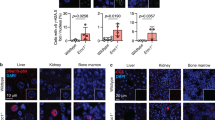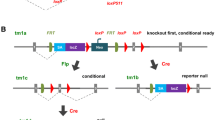Abstract
Our laboratory is conducting experiments designed to characterize the role of p53 in gene expression in the TSG-p53® mouse model. In the study reported here, gene expression levels in tissue derived from the testis, liver, and heart of male, 8–9 week old, p53 wild-type (WT), heterozygous (HET) or knockout (KO) mice were determined utilizing a targeted qPCR 84-gene array. The heart, liver and testis were selected because of the unique function and rate of cell division of each tissue. The genes on the arrays were categorized into three Functional Gene Groups, Apoptosis, Cell-Cycle and DNA Repair. Differences in expression of the functional groups were determined by multivariate analysis of variance (MANOVA) and significant (P < 0.05) differences in their expression were found among the heart, liver and testis. Further, the expression of the Functional Gene Groups in each of these tissues was also significantly affected by p53 genotype. These data indicate that gene expression in unperturbed tissue is influenced by the status of p53 genotype, and relates, at least partially, to the function of the tissue.
Similar content being viewed by others
References
Almon E, Goldfinger N, Kapon A, Schwartz D, Levine AJ, Rotter V (1993) Testicular tissue-specific expression of the p53 suppressor gene. Dev Biol 156(1):107–116
Beumer TL, Roepers-Gajadien HL, Gademan IS, van Buul PP, Gil-Gomez G, Rutgers DH, de Rooij DG (1998) The role of the tumor suppressor p53 in spermatogenesis. Cell Death Differ 5(8):669–677
Bustin SA, Benes V, Garson JA, Hellemans J, Huggett J, Kubista M, Mueller R, Nolan T, Pfaffl MW, Shipley GL, Vandesompele J, Wittwer CT (2009) The miqe guidelines: Minimum information for publication of quantitative real-time pcr experiments. Clin Chem 55(4):611–622
Donehower LA, Harvey M, Slagle BL, McArthur MJ, Montgomery CA Jr, Butel JS, Bradley A (1992) Mice deficient for p53 are developmentally normal but susceptible to spontaneous tumours. Nature 356(6366):215–221
Jacks T, Remington L, Williams BO, Schmitt EM, Halachmi S, Bronson RT, Weinberg RA (1994) Tumor spectrum analysis in p53-mutant mice. Curr Biol 4(1):1–7
Kulkarni R, Petibone DM, Chang CW, Chen JJ, Tolleson WH, Melchior WB Jr, Churchwell MI, Beland FA, Morris SM (2011) Effect of p53 genotype on gene expression and DNA adducts in ENU-exposed mice. In: Casciano DA, Sahu SC (eds) Handbook of systems toxicology, vol 1. John Wiley & Sons, Ltd, UK, pp 53–66
Kumar D, Jugdutt BI (2003) Apoptosis and oxidants in the heart. J Lab Clin Med 142(5):288–297
Langie SA, Knaapen AM, Houben JM, van Kempen FC, de Hoon JP, Gottschalk RW, Godschalk RW, van Schooten FJ (2007) The role of glutathione in the regulation of nucleotide excision repair during oxidative stress. Toxicol Lett 168(3):302–309
Livak KJ, Schmittgen TD (2001) Analysis of relative gene expression data using real-time quantitative pcr and the 2(-delta delta c(t)) method. Methods 25(4):402–408
Lomonosova E, Chinnadurai G (2008) Bh3-only proteins in apoptosis and beyond: An overview. Oncogene 27(Suppl 1):S2–S19
Moll UM, Wolff S, Speidel D, Deppert W (2005) Transcription-independent pro-apoptotic functions of p53. Curr Opin Cell Biol 17(6):631–636
Nalam RL, Andreu-Vieyra C, Braun RE, Akiyama H, Matzuk MM (2009) Retinoblastoma protein plays multiple essential roles in the terminal differentiation of sertoli cells. Mol Endocrinol 23(11):1900–1913
Ohta H, Aizawa S, Nishimune Y (2003) Functional analysis of the p53 gene in apoptosis induced by heat stress or loss of stem cell factor signaling in mouse male germ cells. Biol Reprod 68(6):2249–2254
Paul C, Povey JE, Lawrence NJ, Selfridge J, Melton DW, Saunders PT (2007) Deletion of genes implicated in protecting the integrity of male germ cells has differential effects on the incidence of DNA breaks and germ cell loss. PLoS One 2(10):e989
Purdie CA, Harrison DJ, Peter A, Dobbie L, White S, Howie SE, Salter DM, Bird CC, Wyllie AH, Hooper ML et al (1994) Tumour incidence, spectrum and ploidy in mice with a large deletion in the p53 gene. Oncogene 9(2):603–609
Regula KM, Kirshenbaum LA (2004) Breaking down cell-cycle barriers in the adult heart. Circ Res 94(12):1524–1526
Salehi F, Kovacs K, Scheithauer BW, Lloyd RV, Cusimano M (2008) Pituitary tumor-transforming gene in endocrine and other neoplasms: A review and update. Endocr Relat Cancer 15(3):721–743
Salmand PA, Jungas T, Fernandez M, Conter A, Christians ES (2008) Mouse heat-shock factor 1 (hsf1) is involved in testicular response to genotoxic stress induced by doxorubicin. Biol Reprod 79(6):1092–1101
Schwartz D, Goldfinger N, Kam Z, Rotter V (1999) P53 controls low DNA damage-dependent premeiotic checkpoint and facilitates DNA repair during spermatogenesis. Cell Growth Differ 10(10):665–675
Shetty G, Shao SH, Weng CC (2008) P53-dependent apoptosis in the inhibition of spermatogonial differentiation in juvenile spermatogonial depletion (utp14bjsd) mice. Endocrinology 149(6):2773–2781
Speidel D, Helmbold H, Deppert W (2006) Dissection of transcriptional and non-transcriptional p53 activities in the response to genotoxic stress. Oncogene 25(6):940–953
Tfelt-Hansen J, Kanuparthi D, Chattopadhyay N (2006) The emerging role of pituitary tumor transforming gene in tumorigenesis. Clin Med Res 4(2):130–137
Tsai CA, Chen JJ (2009) Multivariate analysis of variance test for gene set analysis. Bioinformatics 25(7):897–903
Vandesompele J, De Preter K, Pattyn F, Poppe B, Van Roy N, De Paepe A, Speleman F (2002) Accurate normalization of real-time quantitative rt-pcr data by geometric averaging of multiple internal control genes. Genome Biol 3(7):RESEARCH0034
Yin Y, Stahl BC, DeWolf WC, Morgentaler A (1998) P53-mediated germ cell quality control in spermatogenesis. Dev Biol 204(1):165–171
Acknowledgments
The authors would like to thank G. Ackerman and O. Domon for initiating this project, as well as F. Beland and M. Manjanatha for useful comments on the manuscript.
Author information
Authors and Affiliations
Corresponding author
Electronic supplementary material
Below is the link to the electronic supplementary material.
Rights and permissions
About this article
Cite this article
Petibone, D.M., Kulkarni, R.M., Chang, CW. et al. Evaluation of p53 genotype on gene expression in the testis, liver, and heart from male C57BL/6 mice. Transgenic Res 21, 257–263 (2012). https://doi.org/10.1007/s11248-011-9526-6
Received:
Accepted:
Published:
Issue Date:
DOI: https://doi.org/10.1007/s11248-011-9526-6




